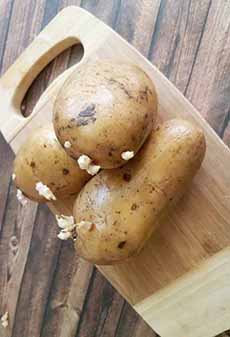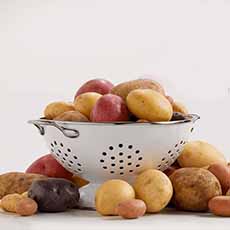|
September is National Potato Month (August 19th is National Potato Day). While we’ll share recipes later in the month, today we have a safety message.
You’ve probably never heard of getting glycoalkaloid toxicity from potatoes.
The effects are mostly gastrointestinal. They are often delayed 8 to 10 hours after consuming a bad potato.
The poisonous ingredient is solanine*, which is very toxic even in small amounts (here’s more information).
The compound mostly resides in the stem and leaves, as well as in green potatoes and new sprouts (eyes, or buds).
You can avoid it by only buying potatoes as you need them, storing them in a cool and dry place—not in the refrigerator.
Potatoes will naturally sprout around 120-150 days after harvesting. To keep them fresh for as long as possible:
Store them in a cool place (not cold), well ventilated and dark. The ideal temperature range is 42° 55°F. Some humidity is helpful.
Don’t store potatoes in a plastic bag without holes. Harvested potatoes continue to breath and any trapped moisture will make the potatoes age more quickly.
Don’t leave potatoes on the countertop. They will turn green from the light.
>Don’t store potatoes in the fridge. The cold will convert the potato starch to sugar, which causes problems when cooking. Fried potatoes will fry up with dark flesh, and baked or mashed potatoes will taste sweet.
DO YOU HAVE TO THROW OUT POTATOES THAT HAVE SPROUTED?
According to Dr. David Douches, director of the Potato Breeding and Genetics Program at Michigan State University, you can still eat them.
However, the sprouts must be removed and discarded because they aren’t edible.
When a potato begins to sprout, the starch inside the potato converts to sugar, enabling the sprout to grow.
If the potato is still firm to the touch, it’s fine to cook it. Just remove the sprouts, and any soft spots. The potato will still have most of its nutrients.
But if the potato is wrinkled and shrunken and the sprouts are long, throw it out.
Never eat potatoes that are green below the skin or otherwise spoiled.
Remember the well-worn food adage: When in doubt, throw it out.
To prepare a sprouted potato for cooking:
Snap off the eyes. Peel or scrub off the rest of the eye under cold running water.
Use a paring knife or vegetable peeler to remove any remainder.
TIPS
|
|

[1] If the potato is still firm, cut away the eyes with a paring knife (photo © Best Food Facts).

[2] Remove the eyes under running water (photo © National Capital Poison Center).

[3] Just buy what you need. You don’t know how long ago the potatoes were harvested; after 120 days they can begin to sprout (photo © Potatoes USA).
|
|
Don’t Freeze Potatoes. While you can store potatoes in a garage or other cool place, don’t let them freeze. You’ll have to toss them.
Plant The Eyes. Like avocado pits, you can plant the eyes—or the entire sprouted potato. You’ll get at least a plant, if not a potato. However…
Serious Growing. If you want to grow a crop of potatoes, use certified potato seeds from nurseries.
POTATO HISTORY
Potatoes are native to the Andes Mountains of Peru. Here’s the history of our beloved spuds and the different types of potatoes.
_______________
*Solanine is found in species of the Nightshade family (Solanaceae), within the genus Solanum. This includes the potato (Solanum tuberosum), the tomato (Solanum lycopersicum), and the eggplant (Solanum melongena). Bell and chile peppers are a different genus in the Nightshade family. However, solanine is limited to the potato.
Solanine can occur naturally in any part of the plant, including the leaves, fruit and tubers. It has pesticidal properties, and it is one of the plant’s natural defenses.
|


